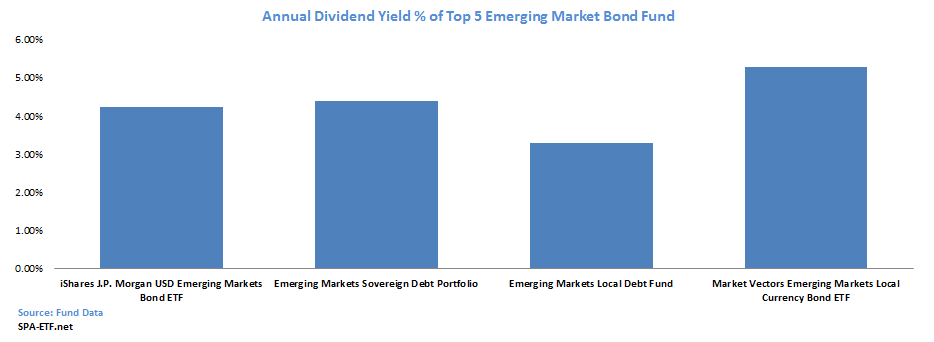How To Find The Best Emerging Market Bond ETF
Post on: 3 Август, 2015 No Comment

Individual emerging market bonds are difficult to purchase and come with significant risk. For this reason, investors are turning to ETFs to gain broad exposure to this market. ETFs dont remove currency, interest rate, and other risk factors inherent to international bond investing, but the diversification that an ETF offers mitigates these risks and can provide lower volatility
.Investors can choose from a wide variety of emerging market bond ETFs. including corporate and government bond exposure. For more targeted exposure, country specific ETFs in the emerging market space are available as well [see Free ETF Country Exposure Tool ].
Price Drivers
Bond investors are likely investing with yield in mind, but significant price fluctuation can occur. Investors should understand the factors that may affect the price of the ETF:
Geopolitical Events: With the recent unrest in countries like Libya, Syria and Egypt, geopolitical risk has to be on the minds of investors any time they invest in countries outside of the United States. Recent history has taught all market participants that when a significant event takes place, there is no safe haven in the investing markets [see also Favorite ETF Positions For 5 Super Investors ].
Monetary Policy: The eurozone is a prime example of poor monetary policy having a direct impact on bond issues. Countries like Greece and Spain saw yields reach historic levels causing the eurozone to intervene. Some emerging markets, often without the luxury of a bailout mechanism, face significant risk of further weakening due to monetary policy.
U.S. Interest Rates: With treasury and investment grade corporate yields at extraordinarily low levels in the United States, domestic bonds offer little benefit for the investor looking for high yield. This makes the risk associated with emerging market bond funds more palatable, but that will change in coming years; when U.S. yields rise, international bond ETFs might look less attractive.
Where They Fit
Emerging Market Bond ETFs are ideal for investors looking for higher yield, fixed income exposure outside of the United States. Bond funds arent traditionally thought of as growth vehicles, but in 2012 some of these ETFs saw a gain of more than 20%, making them appropriate for capital appreciation as well as yield. Still, investors looking for capital appreciation should look at equity ETFs for longer-term holdings [see Emerging & Frontier Markets ETFdb Portfolio ].
Factors to Consider
Beta: Because of the volatile nature of emerging markets, these funds often have betas higher than what is considered normal for bond ETFs. With betas as high as .90 for one emerging markets bond fund, investors should understand that some of these bond ETFs are more volatile than their equity counterparts.
Expenses: The average expense ratio for emerging market bond ETFs is 0.53%. Although not unreasonably high, for funds with lower yields and price performance in line with most bond ETFs, every basis point counts when considering the expense-adjusted yield.
The Contenders
PowerShares Emerging Markets Sovereign Debt Portfolio (PCY, B+ ): The most heavily traded of all emerging market bond ETFs, PCY invests in dollar denominated bonds from 22 emerging market countries.
iShares JPMorgan USD Emerging Markets Bond Fund (EMB, A- ): This fund tracks the performance of the JPMorgan EMBI Global Core Index with 76% of its holdings in government bonds and 21% in corporate.

SPDR Barclays Capital Emerging Markets Local Bond ETF (EBND, A ): This fund tracks the performance of an index that includes government bonds outside of the United States denominated in the countrys local currency [see Better-Than-AGG Total Bond Market ETFdb Portfolio ].
Peoples Choice
The two most popular ETFs in this space are the PowerShares Emerging Markets Sovereign Debt Portfolio (PCY) and the iShares JPMorgan USD Emerging Markets Bond Fund (EMB). PCY has an average daily trading volume of 838,000 compared to EMBs 909,000, and EMB has nearly $7 billion in assets compared to PCYs $3 billion. In 2012, EMB gained nearly 17%, while PCY logged in a handsome 21% gain
.Expense Considerations
For investors looking for the non-country specific ETF with the lowest expense ratio. the Market Vectors Emerging Markets Local Currency Bond ETF (EMLC ) has a 0.47% expense ratio. For those looking for commission free emerging market bond ETFs, there are currently five. PCY is available commission free through TD Ameritrade, ELD. ALD. and EMCB through E*Trade, and EMB through Fidelity.
Best Performers
Because this class of ETFs is relatively new, most ETFs in this space are less than one year old. EMB and PCY are not only the best performers in 2012, but they are the only two in the Emerging Markets Bonds ETFdb category that have three year returns. Each returned more than 38% over a three-year period and roughly 20% in 2012.
[For more ETF analysis, make sure to sign up for our free ETF newsletter or try a free seven day trial to ETFdb Pro ]














